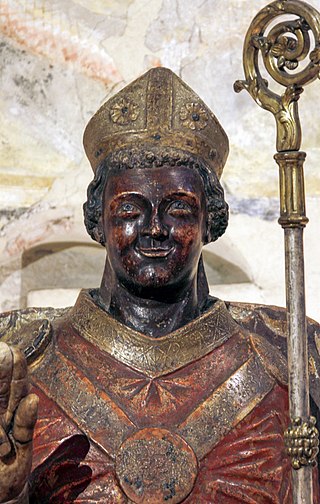
Sorrento is a town overlooking the Bay of Naples in Southern Italy. A popular tourist destination, Sorrento is located on the Sorrentine Peninsula at the southern terminus of a main branch of the Circumvesuviana rail network, within easy access from Naples and Pompei. The town is widely known for its small ceramics, lacework and marquetry (woodwork) shops.

Gotthard, also known as Gothard or Godehard the Bishop, was a German bishop venerated as a saint.

Zeno of Verona was an Afro-Italian Christian figure believed to have either served as Bishop of Verona or died as a martyr. He is venerated as a saint in the Catholic Church and the Orthodox Church.

Saint Renatus is the name of a French and an Italian saint of the Catholic Church who is claimed to be the same person. There are different stories of two saints with by the name Renatus, who were later merged into a single one based on their described similarities and contemporaneity. Both are venerated in Italy and France. They were: Saint Renatus of Sorrento, and Saint Renatus of Angers. Part of their stories seem to be a legend, part incomplete and part deficient historically documented.

Saint Proculus (Proclus) of Pozzuoli was martyred around 305 AD, according to Christian tradition, at the same time as Saint Januarius.

Prosper of Reggio is an Italian saint. Tradition holds that he was a bishop of Reggio Emilia for twenty-two years. Little is known of his life, but documents attest that he was indeed bishop of Reggio Emilia in the fifth century.

Saint Ansovinus was a bishop of Camerino, and is the patron saint of agriculture. His feast day is 13 March.

Saint Justin of Chieti is venerated as an early bishop of Chieti, Italy. His date of death varies, and is sometimes given as the 3rd, 4th, or 6th centuries.

Calimerius was an early bishop of Milan. He is honoured as a Saint in the Catholic and Eastern Orthodox churches and his feast day is on July 31.
Saint Viator of Bergamo is venerated as the second bishop of Bergamo. Viator is traditionally considered the successor of Saint Narnus in that see. Viator's episcopate is considered to have lasted from 343 to 370.

Aspren or Asprenas was a 1st-century Christian saint and venerated as the first Bishop of Naples.

Saint Severus was a bishop of Naples during the 4th and 5th centuries. He is considered the eleventh legitimate Catholic bishop of Naples, and the twelfth overall, succeeding Maximus. His episcopate ran from February 363 to April 29, 409, the traditional date of his death. Between the episcopates of Maximus and Severus, Zosimus, an Arian was established as Bishop, who was condemned as heretical by the Catholic Church.

Eleutherius, also written as Eleutherus, Eleuterus and Eleftherios; sometimes called Liberalis or Liberator Greek: Ἐλευθέριος) and his mother Antia, or Anthia are venerated as Christian saints and martyrs in Greece and Italy.

Castritian was Bishop of Milan in mid 3rd-century. He is honoured as a Saint in the Catholic Church and his feast day is on December 1.

Monas was Bishop of Milan from the end 3rd-century to early 4th-century. He is honoured as a Saint in the Catholic Church and his feast day is on October 12.
Saint Titian of Brescia was a fifth-century bishop of Brescia. In the list of bishops of Brescia, he is considered the fifteenth bishop of Brescia, succeeding Vigilius and preceding Paul II. His episcopate is believed to have occurred at the end of the fifth century.

Anathalon was the first recorded Bishop of Milan and lived at the end 2nd-century or early 3rd-century. A later tradition made him the also the first bishop of Brescia. He is honoured as a saint in the Catholic and Eastern Orthodox Churches, which celebrate his feast day on 24 September. In Milan, however, this is commemorated on 25 September.

Magnus was Archbishop of Milan from 518 to c. 530. He is honoured as a saint in the Catholic Church and Orthodox Church.

Priscus of Nocera was the first bishop of Nocera, patron saint of the city of Nocera Inferiore and of the diocese of Nocera Inferiore-Sarno.

The Basilica minore di San Giacomo Apostolo is a religious building in Chioggia that overlooks on the main square of the city, is a Catholic church located in Chioggia, in the province of Venice, Veneto, Italy.
This church elevated to minor pontifical basilica with the title of Blessed Virgin of the Navicella by Pope Pius X in 1906, it is the second largest church in the historic center of Chioggia immediately after the cathedral.

















